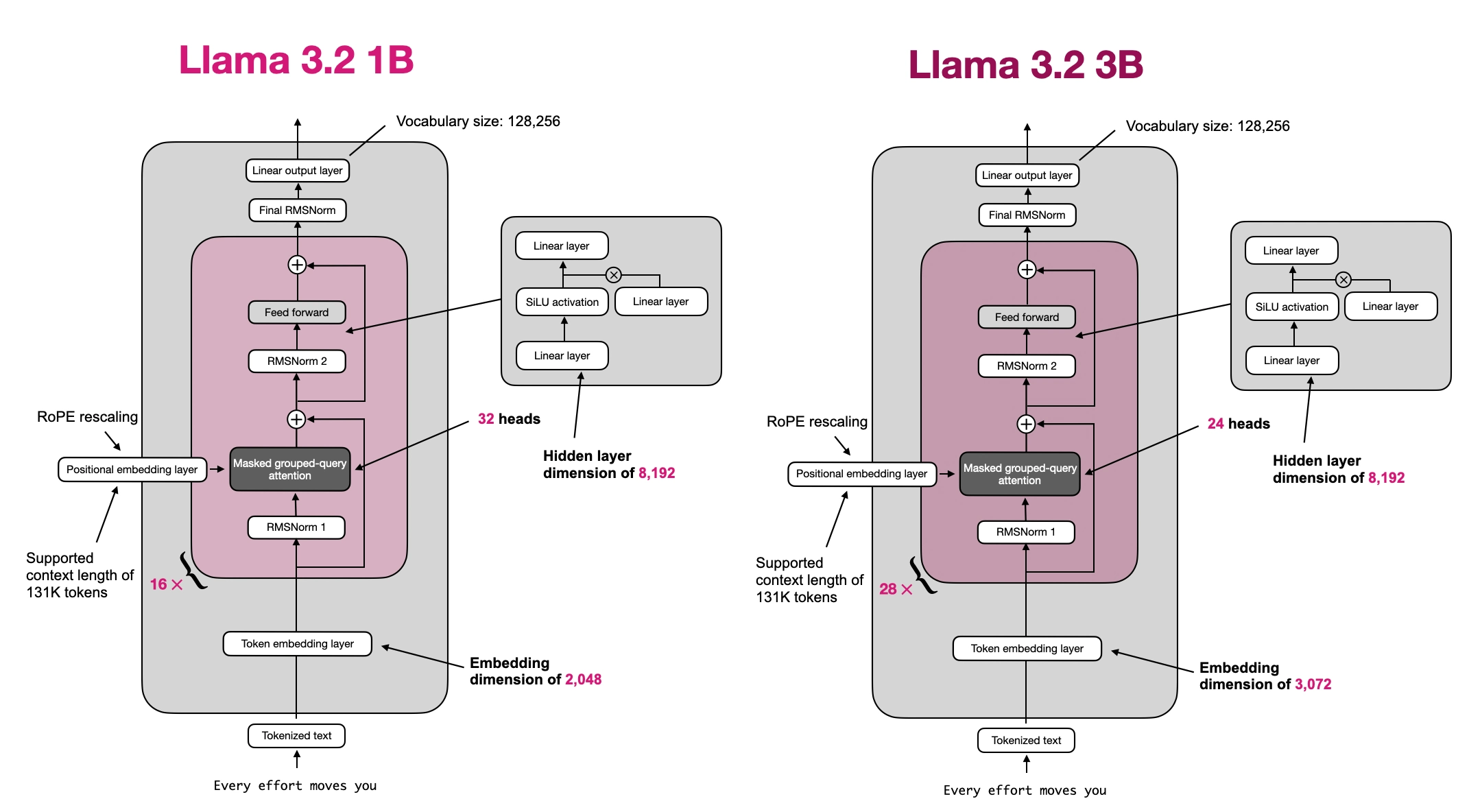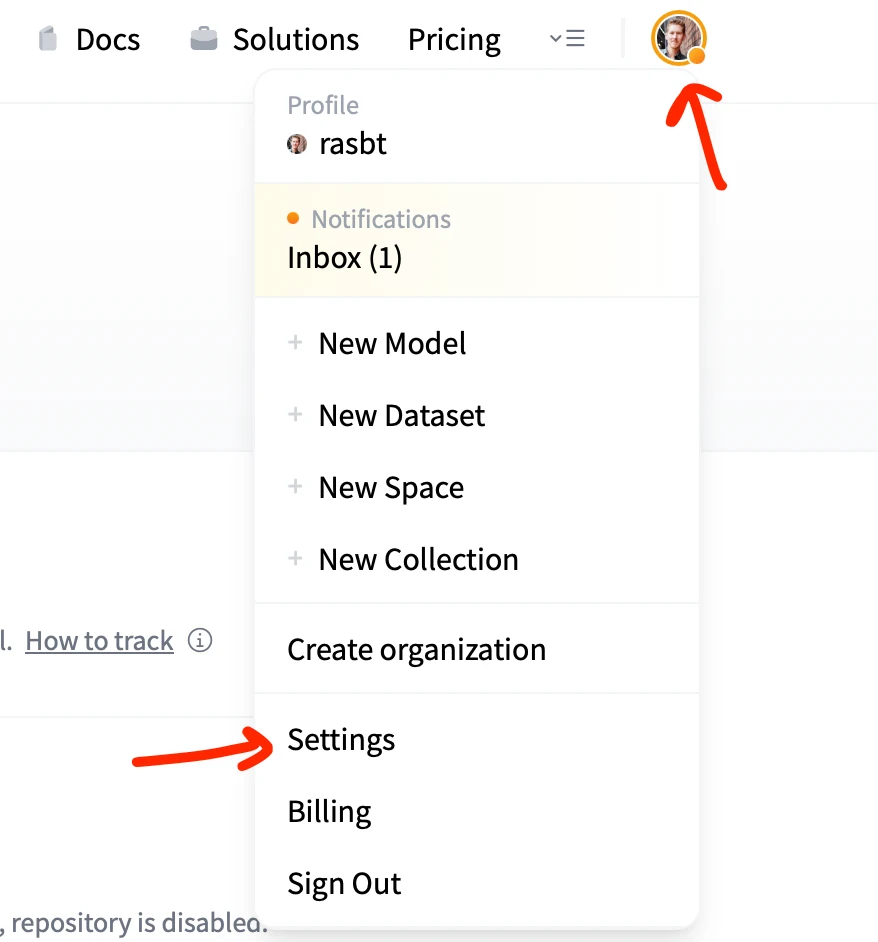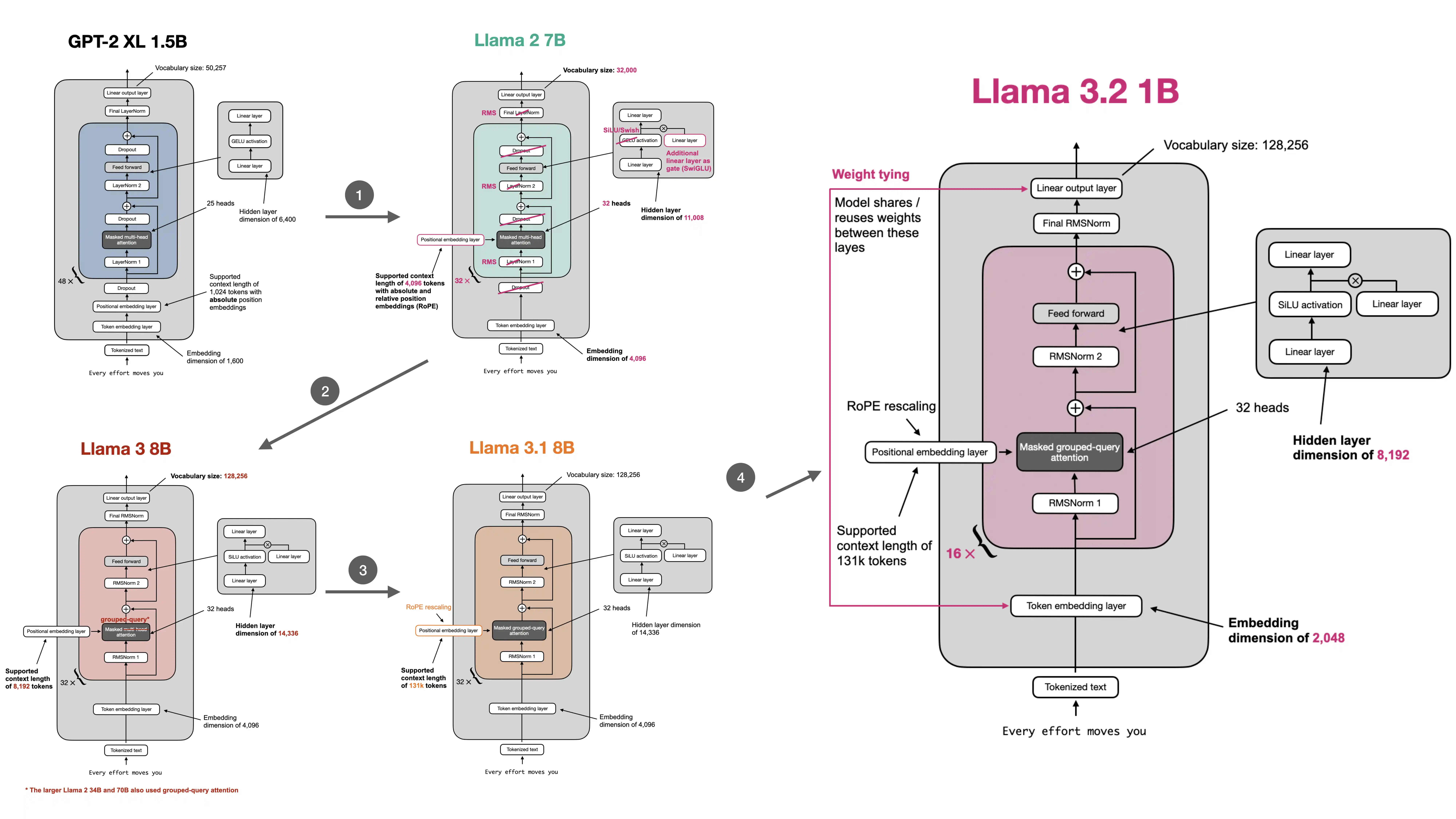新建
Llama 3.2 From Scratch (A Standalone Notebook)

xuxh@dp.tech

推荐镜像 :Basic Image:bohrium-notebook:2023-04-07
推荐机型 :c2_m4_cpu
赞
目录
|
Supplementary code for the Build a Large Language Model From Scratch book by Sebastian Raschka Code repository: https://github.com/rasbt/LLMs-from-scratch |

|
代码
文本
Llama 3.2 From Scratch (A Standalone Notebook)
代码
文本
- This notebook is purposefully minimal and focuses on the code to implement the Llama 3.2 1B and 3B LLMs
- For a step-by-step guide that explains the individual components and the relationship between GPT, Llama 2, and Llama 3, please see the following companion notebooks:

- About the code:
- all code is my own code, mapping the Llama 3 architecture onto the model code implemented in my Build A Large Language Model (From Scratch) book; the code is released under a permissive open-source Apache 2.0 license (see LICENSE.txt)
- the tokenizer code is inspired by the original Llama 3 tokenizer code, which Meta AI used to to extends the Tiktoken GPT-4 tokenizer
- the RoPE rescaling section is inspired by the _compute_llama3_parameters function in the
transformerslibrary
代码
文本
[1]
# pip install -r https://raw.githubusercontent.com/rasbt/LLMs-from-scratch/refs/heads/main/ch05/07_gpt_to_llama/requirements-extra.txt
代码
文本
[2]
from importlib.metadata import version
pkgs = [
"blobfile", # to download pretrained weights
"huggingface_hub", # to download pretrained weights
"tiktoken", # to implement the tokenizer
"torch", # to implement the model
]
for p in pkgs:
print(f"{p} version: {version(p)}")
blobfile version: 3.0.0 huggingface_hub version: 0.25.1 tiktoken version: 0.7.0 torch version: 2.4.0
代码
文本
1. Architecture code
代码
文本
[3]
import torch
import torch.nn as nn
class FeedForward(nn.Module):
def __init__(self, cfg):
super().__init__()
self.fc1 = nn.Linear(cfg["emb_dim"], cfg["hidden_dim"], dtype=cfg["dtype"], bias=False)
self.fc2 = nn.Linear(cfg["emb_dim"], cfg["hidden_dim"], dtype=cfg["dtype"], bias=False)
self.fc3 = nn.Linear(cfg["hidden_dim"], cfg["emb_dim"], dtype=cfg["dtype"], bias=False)
def forward(self, x):
x_fc1 = self.fc1(x)
x_fc2 = self.fc2(x)
x = nn.functional.silu(x_fc1) * x_fc2
return self.fc3(x)
代码
文本
[4]
def precompute_rope_params(head_dim, theta_base=10000, context_length=4096, freq_config=None):
assert head_dim % 2 == 0, "Embedding dimension must be even"
# Compute the inverse frequencies
inv_freq = 1.0 / (theta_base ** (torch.arange(0, head_dim // 2) / (head_dim // 2)))
# Frequency adjustments
if freq_config is not None:
low_freq_wavelen = freq_config["original_context_length"] / freq_config["low_freq_factor"]
high_freq_wavelen = freq_config["original_context_length"] / freq_config["high_freq_factor"]
wavelen = 2 * torch.pi / inv_freq
inv_freq_llama = torch.where(
wavelen > low_freq_wavelen, inv_freq / freq_config["factor"], inv_freq
)
smooth_factor = (freq_config["original_context_length"] / wavelen - freq_config["low_freq_factor"]) / (
freq_config["high_freq_factor"] - freq_config["low_freq_factor"]
)
smoothed_inv_freq = (
(1 - smooth_factor) * (inv_freq / freq_config["factor"]) + smooth_factor * inv_freq
)
is_medium_freq = (wavelen <= low_freq_wavelen) & (wavelen >= high_freq_wavelen)
inv_freq_llama = torch.where(is_medium_freq, smoothed_inv_freq, inv_freq_llama)
inv_freq = inv_freq_llama
# Generate position indices
positions = torch.arange(context_length)
# Compute the angles
angles = positions[:, None] * inv_freq[None, :] # Shape: (context_length, head_dim // 2)
# Expand angles to match the head_dim
angles = torch.cat([angles, angles], dim=1) # Shape: (context_length, head_dim)
# Precompute sine and cosine
cos = torch.cos(angles)
sin = torch.sin(angles)
return cos, sin
def compute_rope(x, cos, sin):
# x: (batch_size, num_heads, seq_len, head_dim)
batch_size, num_heads, seq_len, head_dim = x.shape
assert head_dim % 2 == 0, "Head dimension must be even"
# Split x into first half and second half
x1 = x[..., : head_dim // 2] # First half
x2 = x[..., head_dim // 2 :] # Second half
# Adjust sin and cos shapes
cos = cos[:seq_len, :].unsqueeze(0).unsqueeze(0) # Shape: (1, 1, seq_len, head_dim)
sin = sin[:seq_len, :].unsqueeze(0).unsqueeze(0)
# Apply the rotary transformation
rotated = torch.cat((-x2, x1), dim=-1)
x_rotated = (x * cos) + (rotated * sin)
return x_rotated.to(dtype=x.dtype)
代码
文本
[5]
class SharedBuffers:
_buffers = {}
@staticmethod
def get_buffers(context_length, head_dim, rope_base, freq_config, dtype=torch.float32):
key = (context_length, head_dim, rope_base, tuple(freq_config.values()) if freq_config else freq_config, dtype)
if key not in SharedBuffers._buffers:
# Create or fetch the buffers
mask = torch.triu(torch.ones(context_length, context_length), diagonal=1)
cos, sin = precompute_rope_params(head_dim, rope_base, context_length, freq_config)
if dtype is not None:
cos = cos.to(dtype)
sin = sin.to(dtype)
SharedBuffers._buffers[key] = (mask, cos, sin)
return SharedBuffers._buffers[key]
class GroupedQueryAttention(nn.Module):
def __init__(
self, d_in, d_out, context_length, num_heads,
num_kv_groups,
rope_base=10_000,
rope_config=None,
dtype=None
):
super().__init__()
assert d_out % num_heads == 0, "d_out must be divisible by num_heads"
assert num_heads % num_kv_groups == 0, "num_heads must be divisible by num_kv_groups"
self.d_out = d_out
self.num_heads = num_heads
self.head_dim = d_out // num_heads
self.W_key = nn.Linear(d_in, num_kv_groups * self.head_dim, bias=False, dtype=dtype)
self.W_value = nn.Linear(d_in, num_kv_groups * self.head_dim, bias=False, dtype=dtype)
self.num_kv_groups = num_kv_groups
self.group_size = num_heads // num_kv_groups
self.W_query = nn.Linear(d_in, d_out, bias=False, dtype=dtype)
self.out_proj = nn.Linear(d_out, d_out, bias=False, dtype=dtype)
# Fetch buffers using SharedBuffers
mask, cos, sin = SharedBuffers.get_buffers(context_length, self.head_dim, rope_base, rope_config, dtype)
self.register_buffer("mask", mask)
self.register_buffer("cos", cos)
self.register_buffer("sin", sin)
def forward(self, x):
b, num_tokens, d_in = x.shape
queries = self.W_query(x) # Shape: (b, num_tokens, d_out)
keys = self.W_key(x) # Shape: (b, num_tokens, num_kv_groups * head_dim)
values = self.W_value(x) # Shape: (b, num_tokens, num_kv_groups * head_dim)
# Reshape queries, keys, and values
queries = queries.view(b, num_tokens, self.num_heads, self.head_dim)
keys = keys.view(b, num_tokens, self.num_kv_groups, self.head_dim)
values = values.view(b, num_tokens, self.num_kv_groups, self.head_dim)
# Transpose keys, values, and queries
keys = keys.transpose(1, 2) # Shape: (b, num_heads, num_tokens, head_dim)
values = values.transpose(1, 2) # Shape: (b, num_heads, num_tokens, head_dim)
queries = queries.transpose(1, 2) # Shape: (b, num_query_groups, num_tokens, head_dim)
# Apply RoPE
keys = compute_rope(keys, self.cos, self.sin)
queries = compute_rope(queries, self.cos, self.sin)
# Expand keys and values to match the number of heads
# Shape: (b, num_heads, num_tokens, head_dim)
keys = keys.repeat_interleave(self.group_size, dim=1) # Shape: (b, num_heads, num_tokens, head_dim)
values = values.repeat_interleave(self.group_size, dim=1) # Shape: (b, num_heads, num_tokens, head_dim)
# For example, before repeat_interleave along dim=1 (query groups):
# [K1, K2]
# After repeat_interleave (each query group is repeated group_size times):
# [K1, K1, K2, K2]
# If we used regular repeat instead of repeat_interleave, we'd get:
# [K1, K2, K1, K2]
# Compute scaled dot-product attention (aka self-attention) with a causal mask
# Shape: (b, num_heads, num_tokens, num_tokens)
attn_scores = queries @ keys.transpose(2, 3) # Dot product for each head
# Original mask truncated to the number of tokens and converted to boolean
mask_bool = self.mask.bool()[:num_tokens, :num_tokens]
# Use the mask to fill attention scores
attn_scores.masked_fill_(mask_bool, -torch.inf)
attn_weights = torch.softmax(attn_scores / keys.shape[-1]**0.5, dim=-1)
assert keys.shape[-1] == self.head_dim
# Shape: (b, num_tokens, num_heads, head_dim)
context_vec = (attn_weights @ values).transpose(1, 2)
# Combine heads, where self.d_out = self.num_heads * self.head_dim
context_vec = context_vec.reshape(b, num_tokens, self.d_out)
context_vec = self.out_proj(context_vec) # optional projection
return context_vec
代码
文本
[6]
class TransformerBlock(nn.Module):
def __init__(self, cfg):
super().__init__()
self.att = GroupedQueryAttention(
d_in=cfg["emb_dim"],
d_out=cfg["emb_dim"],
context_length=cfg["context_length"],
num_heads=cfg["n_heads"],
num_kv_groups=cfg["n_kv_groups"],
rope_base=cfg["rope_base"],
rope_config=cfg["rope_freq"],
dtype=cfg["dtype"]
)
self.ff = FeedForward(cfg)
self.norm1 = nn.RMSNorm(cfg["emb_dim"], eps=1e-5)
self.norm2 = nn.RMSNorm(cfg["emb_dim"], eps=1e-5)
def forward(self, x):
# Shortcut connection for attention block
shortcut = x
x = self.norm1(x)
x = self.att(x.to(torch.bfloat16)) # Shape [batch_size, num_tokens, emb_size]
x = x + shortcut # Add the original input back
# Shortcut connection for feed-forward block
shortcut = x
x = self.norm2(x)
x = self.ff(x.to(torch.bfloat16))
x = x + shortcut # Add the original input back
return x
代码
文本
[7]
class Llama3Model(nn.Module):
def __init__(self, cfg):
super().__init__()
self.tok_emb = nn.Embedding(cfg["vocab_size"], cfg["emb_dim"], dtype=cfg["dtype"])
self.trf_blocks = nn.Sequential(
*[TransformerBlock(cfg) for _ in range(cfg["n_layers"])])
self.final_norm = nn.RMSNorm(cfg["emb_dim"], eps=1e-5)
self.out_head = nn.Linear(cfg["emb_dim"], cfg["vocab_size"], bias=False, dtype=cfg["dtype"])
def forward(self, in_idx):
tok_embeds = self.tok_emb(in_idx)
x = tok_embeds
x = self.trf_blocks(x)
x = self.final_norm(x)
logits = self.out_head(x.to(torch.bfloat16))
return logits
代码
文本
2. Initialize model
代码
文本
- The remainder of this notebook uses the Llama 3.2 1B model; to use the 3B model variant, just uncomment the second configuration file in the following code cell
代码
文本
[8]
# Llama 3.2 1B
LLAMA32_CONFIG = {
"vocab_size": 128_256, # Vocabulary size
"context_length": 131_072, # Context length
"emb_dim": 2048, # Embedding dimension
"n_heads": 32, # Number of attention heads
"n_layers": 16, # Number of layers
"hidden_dim": 8192, # Size of the intermediate dimension in FeedForward
"n_kv_groups": 8, # Key-Value groups for grouped-query attention
"rope_base": 50_000, # The base in RoPE's "theta"
"dtype": torch.bfloat16, # Lower-precision dtype to save memory
"rope_freq": { # RoPE frequency scaling
"factor": 32.0,
"low_freq_factor": 1.0,
"high_freq_factor": 4.0,
"original_context_length": 8192,
}
}
# Llama 3.2 3B
# LLAMA32_CONFIG = {
# "vocab_size": 128_256, # Vocabulary size
# "context_length": 131_000, # Context length
# "emb_dim": 3072, # Embedding dimension
# "n_heads": 24, # Number of attention heads
# "n_layers": 28, # Number of layers
# "hidden_dim": 8192, # Size of the intermediate dimension in FeedForward
# "n_kv_groups": 8, # Key-Value groups for grouped-query attention
# "rope_base": 50_000, # The base in RoPE's "theta"
# "dtype": torch.bfloat16, # Lower-precision dtype to save memory
# "rope_freq": { # RoPE frequency scaling
# "factor": 32.0,
# "low_freq_factor": 1.0,
# "high_freq_factor": 4.0,
# "original_context_length": 8192,
# }
# }
LLAMA_SIZE_STR = "1B" if LLAMA32_CONFIG["emb_dim"] == 2048 else "3B"
代码
文本
- Reduce the context length so the model would work fine on a MacBook Air (if you have more RAM, feel free to comment out the lines below):
代码
文本
[9]
LLAMA32_CONFIG["context_length"] = 8192
代码
文本
[10]
model = Llama3Model(LLAMA32_CONFIG)
代码
文本
- The following is expected to print True to confirm buffers are reused instead of being (wastefully) recreated:
代码
文本
[11]
# Check buffers
print(model.trf_blocks[0].att.mask is model.trf_blocks[-1].att.mask)
print(model.trf_blocks[0].att.cos is model.trf_blocks[-1].att.cos)
print(model.trf_blocks[0].att.sin is model.trf_blocks[-1].att.sin)
True True True
代码
文本
[12]
total_params = sum(p.numel() for p in model.parameters())
print(f"Total number of parameters: {total_params:,}")
# Account for weight tying
total_params_normalized = total_params - model.tok_emb.weight.numel()
print(f"\nTotal number of unique parameters: {total_params_normalized:,}")
Total number of parameters: 1,498,482,688 Total number of unique parameters: 1,235,814,400
代码
文本
[13]
def model_memory_size(model, input_dtype=torch.float32):
total_params = 0
total_grads = 0
for param in model.parameters():
# Calculate total number of elements per parameter
param_size = param.numel()
total_params += param_size
# Check if gradients are stored for this parameter
if param.requires_grad:
total_grads += param_size
# Calculate buffer size (non-parameters that require memory)
total_buffers = sum(buf.numel() for buf in model.buffers())
# Size in bytes = (Number of elements) * (Size of each element in bytes)
# We assume parameters and gradients are stored in the same type as input dtype
element_size = torch.tensor(0, dtype=input_dtype).element_size()
total_memory_bytes = (total_params + total_grads + total_buffers) * element_size
# Convert bytes to gigabytes
total_memory_gb = total_memory_bytes / (1024**3)
return total_memory_gb
print(f"float32 (PyTorch default): {model_memory_size(model, input_dtype=torch.float32):.2f} GB")
print(f"bfloat16: {model_memory_size(model, input_dtype=torch.bfloat16):.2f} GB")
float32 (PyTorch default): 11.42 GB bfloat16: 5.71 GB
代码
文本
[14]
if torch.cuda.is_available():
device = torch.device("cuda")
elif torch.backends.mps.is_available():
device = torch.device("mps")
else:
device = torch.device("cpu")
model.to(device);
代码
文本
3. Load tokenizer
代码
文本
[15]
import os
from pathlib import Path
import tiktoken
from tiktoken.load import load_tiktoken_bpe
class Tokenizer:
def __init__(self, model_path):
assert os.path.isfile(model_path), f"Model file {model_path} not found"
mergeable_ranks = load_tiktoken_bpe(model_path)
num_base_tokens = len(mergeable_ranks)
self.special_tokens = {
"<|begin_of_text|>": 128000,
"<|end_of_text|>": 128001,
"<|start_header_id|>": 128006,
"<|end_header_id|>": 128007,
"<|eot_id|>": 128009,
}
self.special_tokens.update({
f"<|reserved_{i}|>": 128002 + i for i in range(256) if (128002 + i) not in self.special_tokens.values()
})
self.model = tiktoken.Encoding(
name=Path(model_path).name,
pat_str=r"(?i:'s|'t|'re|'ve|'m|'ll|'d)|[^\r\n\p{L}\p{N}]?\p{L}+|\p{N}{1,3}| ?[^\s\p{L}\p{N}]+[\r\n]*|\s*[\r\n]+|\s+(?!\S)|\s+",
mergeable_ranks=mergeable_ranks,
special_tokens=self.special_tokens
)
def encode(self, text, bos=False, eos=False, allowed_special=set(), disallowed_special=()):
if bos:
tokens = [self.special_tokens["<|begin_of_text|>"]]
else:
tokens = []
tokens += self.model.encode(text, allowed_special=allowed_special, disallowed_special=disallowed_special)
if eos:
tokens.append(self.special_tokens["<|end_of_text|>"])
return tokens
def decode(self, tokens):
return self.model.decode(tokens)
class ChatFormat:
def __init__(self, tokenizer):
self.tokenizer = tokenizer
def encode_header(self, message):
tokens = []
tokens.append(self.tokenizer.special_tokens["<|start_header_id|>"])
tokens.extend(self.tokenizer.encode(message["role"], bos=False, eos=False))
tokens.append(self.tokenizer.special_tokens["<|end_header_id|>"])
tokens.extend(self.tokenizer.encode("\n\n", bos=False, eos=False))
return tokens
def encode(self, text):
message = {
"role": "user",
"content": text
}
tokens = self.encode_header(message)
tokens.extend(
self.tokenizer.encode(message["content"].strip(), bos=False, eos=False)
)
tokens.append(self.tokenizer.special_tokens["<|eot_id|>"])
return tokens
def decode(self, token_ids):
return self.tokenizer.decode(token_ids)
代码
文本
- Please note that Meta AI requires that you accept the Llama 3.2 licensing terms before you can download the files; to do this, you have to create a Hugging Face Hub account and visit the meta-llama/Llama-3.2-1B repository to accept the terms
- Next, you will need to create an access token; to generate an access token with READ permissions, click on the profile picture in the upper right and click on "Settings"

- Then, create and copy the access token so you can copy & paste it into the next code cell

代码
文本
[16]
from huggingface_hub import login
login()
代码
文本
[17]
from huggingface_hub import hf_hub_download
tokenizer_file_path = hf_hub_download(
repo_id=f"meta-llama/Llama-3.2-{LLAMA_SIZE_STR}-Instruct",
filename="original/tokenizer.model",
local_dir="llama32-files"
)
代码
文本
[18]
tokenizer = Tokenizer(tokenizer_file_path)
chat_tokenizer = ChatFormat(tokenizer)
代码
文本
4. Load pretrained weights
代码
文本
[19]
def assign(left, right, tensor_name="unknown"):
if left.shape != right.shape:
raise ValueError(f"Shape mismatch in tensor '{tensor_name}'. Left: {left.shape}, Right: {right.shape}")
if isinstance(right, torch.Tensor):
return torch.nn.Parameter(right.clone().detach())
else:
return torch.nn.Parameter(torch.tensor(right))
def load_weights_into_llama(model, param_config, params):
model.tok_emb.weight = assign(model.tok_emb.weight, params["model.embed_tokens.weight"], "model.embed_tokens.weight")
for l in range(param_config["n_layers"]):
# Load attention weights
model.trf_blocks[l].att.W_query.weight = assign(
model.trf_blocks[l].att.W_query.weight,
params[f"model.layers.{l}.self_attn.q_proj.weight"],
f"model.layers.{l}.self_attn.q_proj.weight"
)
model.trf_blocks[l].att.W_key.weight = assign(
model.trf_blocks[l].att.W_key.weight,
params[f"model.layers.{l}.self_attn.k_proj.weight"],
f"model.layers.{l}.self_attn.k_proj.weight"
)
model.trf_blocks[l].att.W_value.weight = assign(
model.trf_blocks[l].att.W_value.weight,
params[f"model.layers.{l}.self_attn.v_proj.weight"],
f"model.layers.{l}.self_attn.v_proj.weight"
)
model.trf_blocks[l].att.out_proj.weight = assign(
model.trf_blocks[l].att.out_proj.weight,
params[f"model.layers.{l}.self_attn.o_proj.weight"],
f"model.layers.{l}.self_attn.o_proj.weight"
)
model.trf_blocks[l].norm1.weight = assign(
model.trf_blocks[l].norm1.weight,
params[f"model.layers.{l}.input_layernorm.weight"],
f"model.layers.{l}.input_layernorm.weight"
)
# Load FeedForward weights
model.trf_blocks[l].ff.fc1.weight = assign(
model.trf_blocks[l].ff.fc1.weight,
params[f"model.layers.{l}.mlp.gate_proj.weight"],
f"model.layers.{l}.mlp.gate_proj.weight"
)
model.trf_blocks[l].ff.fc2.weight = assign(
model.trf_blocks[l].ff.fc2.weight,
params[f"model.layers.{l}.mlp.up_proj.weight"],
f"model.layers.{l}.mlp.up_proj.weight"
)
model.trf_blocks[l].ff.fc3.weight = assign(
model.trf_blocks[l].ff.fc3.weight,
params[f"model.layers.{l}.mlp.down_proj.weight"],
f"model.layers.{l}.mlp.down_proj.weight"
)
model.trf_blocks[l].norm2.weight = assign(
model.trf_blocks[l].norm2.weight,
params[f"model.layers.{l}.post_attention_layernorm.weight"],
f"model.layers.{l}.post_attention_layernorm.weight"
)
# Load output layer weights
model.final_norm.weight = assign(model.final_norm.weight, params["model.norm.weight"], "model.norm.weight")
if "lm_head.weight" in params.keys():
model.out_head.weight = assign(model.out_head.weight, params["lm_head.weight"], "lm_head.weight")
else:
model.out_head.weight = assign(model.out_head.weight, params["model.embed_tokens.weight"], "model.embed_tokens.weight")
print("Model uses weight tying.")
代码
文本
[20]
from safetensors.torch import load_file
if LLAMA_SIZE_STR == "1B":
weights_file = hf_hub_download(
repo_id=f"meta-llama/Llama-3.2-{LLAMA_SIZE_STR}-Instruct",
filename=f"model.safetensors",
local_dir="llama32-files"
)
combined_weights = load_file(weights_file)
else:
combined_weights = {}
for i in range(1, 3):
weights_file = hf_hub_download(
repo_id=f"meta-llama/Llama-3.2-{LLAMA_SIZE_STR}-Instruct",
filename=f"model-0000{i}-of-00002.safetensors",
local_dir="llama32-files"
)
current_weights = load_file(weights_file)
combined_weights.update(current_weights)
load_weights_into_llama(model, LLAMA32_CONFIG, combined_weights)
model.to(device);
Model uses weight tying.
代码
文本
[21]
print("Weight tying:", torch.equal(model.tok_emb.weight, model.out_head.weight))
Weight tying: True
代码
文本
5. Generate text
代码
文本
[22]
def text_to_token_ids(text, tokenizer):
encoded = tokenizer.encode(text)
encoded_tensor = torch.tensor(encoded).unsqueeze(0) # add batch dimension
return encoded_tensor
def token_ids_to_text(token_ids, tokenizer):
flat = token_ids.squeeze(0) # remove batch dimension
return tokenizer.decode(flat.tolist())
def generate(model, idx, max_new_tokens, context_size, temperature=0.0, top_k=None, eos_id=None):
# For-loop is the same as before: Get logits, and only focus on last time step
for _ in range(max_new_tokens):
idx_cond = idx[:, -context_size:]
with torch.no_grad():
logits = model(idx_cond)
logits = logits[:, -1, :]
# New: Filter logits with top_k sampling
if top_k is not None:
# Keep only top_k values
top_logits, _ = torch.topk(logits, top_k)
min_val = top_logits[:, -1]
logits = torch.where(logits < min_val, torch.tensor(float('-inf')).to(logits.device), logits)
# New: Apply temperature scaling
if temperature > 0.0:
logits = logits / temperature
# Apply softmax to get probabilities
probs = torch.softmax(logits, dim=-1) # (batch_size, context_len)
# Sample from the distribution
idx_next = torch.multinomial(probs, num_samples=1) # (batch_size, 1)
# Otherwise same as before: get idx of the vocab entry with the highest logits value
else:
idx_next = torch.argmax(logits, dim=-1, keepdim=True) # (batch_size, 1)
if idx_next == eos_id: # Stop generating early if end-of-sequence token is encountered and eos_id is specified
break
# Same as before: append sampled index to the running sequence
idx = torch.cat((idx, idx_next), dim=1) # (batch_size, num_tokens+1)
return idx
代码
文本
[23]
PROMPT = "What do llamas eat?"
torch.manual_seed(123)
token_ids = generate(
model=model,
idx=text_to_token_ids(PROMPT, chat_tokenizer).to(device),
max_new_tokens=150,
context_size=LLAMA32_CONFIG["context_length"],
top_k=1,
temperature=0.
)
output_text = token_ids_to_text(token_ids, tokenizer)
def clean_text(text, header_end="assistant<|end_header_id|>\n\n"):
# Find the index of the first occurrence of "<|end_header_id|>"
index = text.find(header_end)
if index != -1:
# Return the substring starting after "<|end_header_id|>"
return text[index + len(header_end):].strip() # Strip removes leading/trailing whitespace
else:
# If the token is not found, return the original text
return text
print("Output text:\n", clean_text(output_text))
Output text: Llamas are herbivores, which means they primarily eat plants and plant-based foods. Their diet typically consists of: 1. Grasses: Llamas love to graze on various types of grasses, including tall grasses and short grasses. 2. Hay: Llamas also eat hay, which is a dry, compressed form of grass or other plants. 3. Alfalfa: Alfalfa is a legume that is commonly fed to llamas, as it is high in protein and fiber. 4. Other plants: Llamas will also eat other plants, such as clover, wild grasses, and shrubs. It's worth noting that llamas are adapted to high altitudes and
代码
文本
What's next?
代码
文本
- The notebook was kept purposefully minimal; if you are interested in additional explanation about the individual components, check out the following two companion notebooks:

- For those interested in a comprehensive guide on building a large language model from scratch and gaining a deeper understanding of its mechanics, you might like my Build a Large Language Model (From Scratch)
代码
文本
点个赞吧
本文被以下合集收录
Build a Large Language Model (From Scratch)

xuxh@dp.tech

更新于 2024-10-12
37 篇0 人关注
推荐阅读
公开
Converting a From-Scratch GPT Architecture to Llama 2
xuxh@dp.tech

更新于 2024-10-19
公开
Generating An Instruction Dataset via Llama 3 and Ollama
xuxh@dp.tech

更新于 2024-10-12

